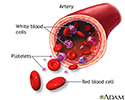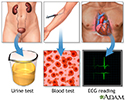RBC count
Erythrocyte count; Red blood cell count; Anemia - RBC count
An RBC count is a blood test that measures how many red blood cells (RBCs) you have.
RBCs contain hemoglobin , which carries oxygen. How much oxygen your body tissues get depends on how many RBCs you have and how well they work.
Hemoglobin
Hemoglobin is a protein in red blood cells that carries oxygen. The hemoglobin test measures how much hemoglobin is in your blood.

How the Test is Performed
A blood sample is needed.
Blood sample
Venipuncture is the collection of blood from a vein. It is most often done for laboratory testing.

How to Prepare for the Test
No special preparation is necessary.
How the Test will Feel
When the needle is inserted to draw blood, some people feel moderate pain. Others feel only a prick or stinging. Afterward, there may be some throbbing or a slight bruise. This soon goes away.
Why the Test is Performed
The RBC count is almost always part of a complete blood count ( CBC ) test.
CBC
A complete blood count (CBC) test measures the following:The number of red blood cells (RBC count)The number of white blood cells (WBC count)The tota...

The test can help diagnose different kinds of anemia (low number of RBCs) and other conditions affecting red blood cells.
Anemia
Anemia is a condition in which the body does not have enough healthy red blood cells. Red blood cells provide oxygen to body tissues. Different type...

Other conditions that may require an RBC count are:
-
Disease that damages kidney blood vessels (
Alport syndrome
)
Alport syndrome
Alport syndrome is an inherited disorder that damages the tiny blood vessels in the kidneys. It also causes hearing loss and eye problems.
 ImageRead Article Now Book Mark Article
ImageRead Article Now Book Mark Article -
White blood cell cancer (
Waldenstrom macroglobulinemia
)
Waldenstrom macroglobulinemia
Waldenstrom macroglobulinemia (WM) is a cancer of the B lymphocytes (a type of white blood cell). WM is associated with the overproduction of protei...
 ImageRead Article Now Book Mark Article
ImageRead Article Now Book Mark Article -
Disorder in which red blood cells break down earlier than normal (
paroxysmal nocturnal hemoglobinuria
)
Paroxysmal nocturnal hemoglobinuria
Paroxysmal nocturnal hemoglobinuria is a rare disease in which red blood cells break down earlier than normal.
 ImageRead Article Now Book Mark Article
ImageRead Article Now Book Mark Article - Bone marrow disorder in which the marrow is replaced by scar tissue (myelofibrosis)
Normal Results
Normal RBC ranges are:
- Male: 4.7 to 6.1 million cells per microliter (cells/mcL)
- Female: 4.2 to 5.4 million cells/mcL
The ranges above are common measurements for results of these tests. Normal value ranges may vary slightly among different laboratories. Some labs use different measurements or test different samples. Talk to your health care provider about the meaning of your specific test results.
What Abnormal Results Mean
Higher than normal numbers of RBCs may be due to:
- Cigarette smoking
-
Problem with heart's structure and function that is present at birth (
congenital heart disease
)
Congenital heart disease
Congenital heart disease (CHD) is a problem with the heart's structure and function that is present at birth.
 ImageRead Article Now Book Mark Article
ImageRead Article Now Book Mark Article -
Failure of the right side of the heart (
cor pulmonale
)
Cor pulmonale
Cor pulmonale is a condition that causes the right side of the heart to fail. Long-term high blood pressure in the arteries of the lung and right ve...
 ImageRead Article Now Book Mark Article
ImageRead Article Now Book Mark Article -
Dehydration
(for example, from severe diarrhea)
Dehydration
Dehydration occurs when your body does not have as much water and fluids as it should. Dehydration can be mild, moderate, or severe, based on how muc...
 ImageRead Article Now Book Mark Article
ImageRead Article Now Book Mark Article - Kidney tumor (renal cell carcinoma)
- Low blood oxygen level (hypoxia)
-
Scarring or thickening of the lungs (
pulmonary fibrosis
)
Pulmonary fibrosis
Idiopathic pulmonary fibrosis is scarring or thickening of the lungs without a known cause.
 ImageRead Article Now Book Mark Article
ImageRead Article Now Book Mark Article -
Bone marrow disease that causes abnormal increase in RBCs (
polycythemia vera
)
Polycythemia vera
Polycythemia vera is a bone marrow disease that leads to an abnormal increase in the number of blood cells. The red blood cells are mostly affected....
Read Article Now Book Mark Article
Your RBC count will increase for several weeks when you are in a higher altitude.
Drugs that can increase the RBC count include:
- Gentamicin
- Methyldopa
Lower-than-normal numbers of RBCs may be due to:
-
Anemia
Anemia
Anemia is a condition in which the body does not have enough healthy red blood cells. Red blood cells provide oxygen to body tissues. Different type...
 ImageRead Article Now Book Mark Article
ImageRead Article Now Book Mark Article - Bleeding
- Bone marrow failure (for example, from radiation, toxins, or tumor)
- Deficiency of a hormone called erythropoietin (caused by kidney disease)
- RBC destruction ( hemolysis ) due to transfusion, blood vessel injury, or other cause
- Leukemia
- Malnutrition
-
Bone marrow cancer called
multiple myeloma
Multiple myeloma
Multiple myeloma is a blood cancer that starts in the plasma cells in the bone marrow. Bone marrow is the soft, spongy tissue found inside most bone...
 ImageRead Article Now Book Mark Article
ImageRead Article Now Book Mark Article -
Too little iron,
copper
, folic acid,
vitamin B6
, or
vitamin B12
in the diet
Copper
Copper is an essential trace mineral present in all body tissues.
Read Article Now Book Mark ArticleVitamin B6
Vitamin B6 is a water-soluble vitamin. Water-soluble vitamins dissolve in water so the body cannot store them. Leftover amounts of the vitamin leav...
 ImageRead Article Now Book Mark Article
ImageRead Article Now Book Mark ArticleVitamin B12
Vitamin B12 is a water-soluble vitamin. Water-soluble vitamins dissolve in water. After the body uses these vitamins, leftover amounts leave the bo...
 ImageRead Article Now Book Mark Article
ImageRead Article Now Book Mark Article - Too much water in the body (overhydration)
- Pregnancy
Drugs that can decrease the RBC count include:
- Chemotherapy drugs
- Chloramphenicol
- Hydantoins
- Quinidine
Risks
There is very little risk involved with having your blood taken. Veins and arteries vary in size from one person to another and from one side of the body to the other. Taking blood from some people may be more difficult than from others.
Other risks associated with having blood drawn are slight, but may include:
- Excessive bleeding
- Fainting or feeling lightheaded
- Hematoma (blood buildup under the skin)
- Infection (a slight risk any time the skin is broken)
References
Bunn HF. Approach to the anemias. In: Goldman L, Schafer AI, eds. Goldman's Cecil Medicine . 24th ed. Philadelphia, PA: Elsevier Saunders; 2015:chap 158.
Goljan EF. Red blood cell disorders. In: Goljan EF, ed. Rapid Review Pathology . 4th ed. Philadelphia, PA: Elsevier Saunders; 2014:chap 12.
-
Blood test - illustration
Blood is drawn from a vein (venipuncture), usually from the inside of the elbow or the back of the hand. A needle is inserted into the vein, and the blood is collected in an air-tight vial or a syringe. Preparation may vary depending on the specific test.
Blood test
illustration
-
Formed elements of blood - illustration
Blood transports oxygen and nutrients to body tissues and returns waste and carbon dioxide. Blood distributes nearly everything that is carried from one area in the body to another place within the body. For example, blood transports hormones from endocrine organs to their target organs and tissues. Blood helps maintain body temperature and normal pH levels in body tissues. The protective functions of blood include clot formation and the prevention of infection.
Formed elements of blood
illustration
-
High blood pressure tests - illustration
Routine lab tests are recommended before beginning treatment of high blood pressure to determine organ or tissue damage or other risk factors. These lab tests include urinalysis, blood cell count, blood chemistry (potassium, sodium, creatinine, fasting glucose, total cholesterol and HDL cholesterol), and an ECG (electrocardiogram). Additional tests may be recommended based on your condition.
High blood pressure tests
illustration
-
Blood test - illustration
Blood is drawn from a vein (venipuncture), usually from the inside of the elbow or the back of the hand. A needle is inserted into the vein, and the blood is collected in an air-tight vial or a syringe. Preparation may vary depending on the specific test.
Blood test
illustration
-
Formed elements of blood - illustration
Blood transports oxygen and nutrients to body tissues and returns waste and carbon dioxide. Blood distributes nearly everything that is carried from one area in the body to another place within the body. For example, blood transports hormones from endocrine organs to their target organs and tissues. Blood helps maintain body temperature and normal pH levels in body tissues. The protective functions of blood include clot formation and the prevention of infection.
Formed elements of blood
illustration
-
High blood pressure tests - illustration
Routine lab tests are recommended before beginning treatment of high blood pressure to determine organ or tissue damage or other risk factors. These lab tests include urinalysis, blood cell count, blood chemistry (potassium, sodium, creatinine, fasting glucose, total cholesterol and HDL cholesterol), and an ECG (electrocardiogram). Additional tests may be recommended based on your condition.
High blood pressure tests
illustration
Review Date: 1/31/2016
Reviewed By: Laura J. Martin, MD, MPH, ABIM Board Certified in Internal Medicine and Hospice and Palliative Medicine, Atlanta, GA. Also reviewed by David Zieve, MD, MHA, Isla Ogilvie, PhD, and the A.D.A.M. Editorial team.



